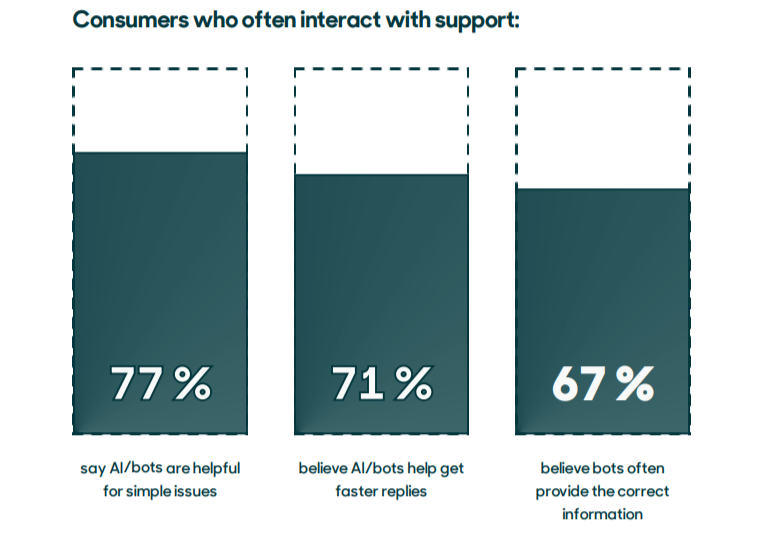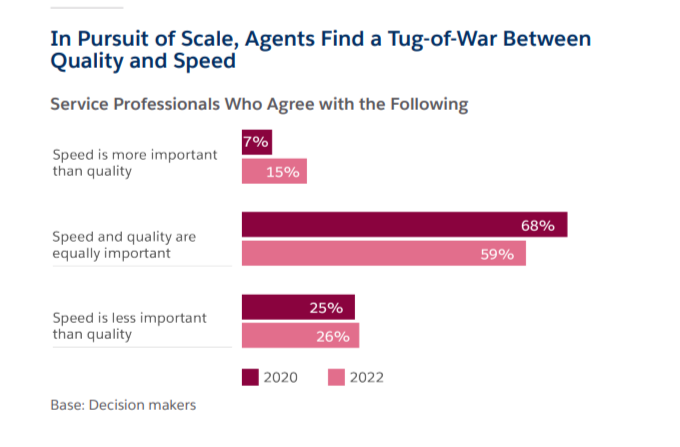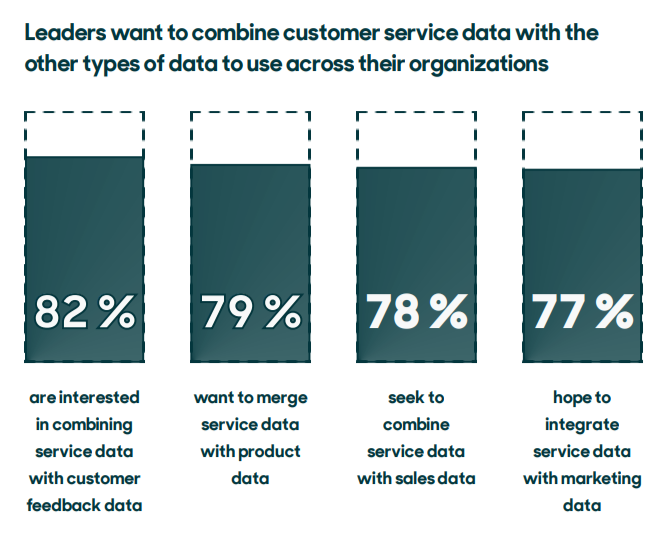As customer expectations rise and emerging technologies shape the industry, customer service has become more than just answering calls in 2025. This drives businesses to keep up with the latest customer service trends, as exceptional service boosts retention, customer loyalty, and growth.
Business2Community has gathered the latest trends and statistics on customer experience, based on various research reports and surveys so your business can provide customers with excellent service and build long-term customer relationships.
Key Customer Service Trends
- Over 60% of customers said they preferred self-service options in customer service.
- 77% of customers find AI chatbots helpful for simple issues.
- For 80% of consumers, customer experience is equally important as the company’s products and services.
- According to 77% of business leaders, personalization increases customer retention.
- 4 in 5 customers expect consistent customer experiences across departments.
What are 2025’s Customer Service Trends?
In 2025, customer service is all about fast responses, empathy skills, and personalization. Hence, companies need to invest in customer service, be it by training staff or streamlining communication channels.
Here are 7 of the latest customer service trends businesses are paying attention to:
1. Phone and Email are Top Channels for Customer Service
From 2020 onwards, digital channels for customer service communication became the norm, as the pandemic accelerated the transformation from in-person to digital.
According to the State of Service report by Salesforce, 77% of companies used phones and 76% used email as customer service channels in 2022. Although they have been the top channels for customer service since 2020, the use of phones and email did decrease over the preceding two years.
Self-service tools such as discussion forums and video support significantly increased in popularity, with a year-over-year growth of 30% and 43%, respectively. Social media, customer portals, live chat, and messaging apps also remained popular, with their use slightly increasing.
For 71% of customers, channel preference depends on the context and demographics. For example, in 2022, Facebook was the top social media app for customer engagement worldwide, but in some countries such as Germany, India, and Singapore, WhatsApp was more popular.
Company leaders planned to use and invest in a wide range of channels to ensure effective customer service. According to a 2022 Deloitte survey, 49% of leaders wanted to invest in chat, 25% in self-service, and 29% in mobile apps, making these the top emerging customer service trends.
The fact that there are multiple channels for different contexts brings around a new customer service trend: omnichannel customer service, a strategy that creates a seamless customer experience across all channels.
An example of an omnichannel experience would be moving from live chat to a phone call without interruption. With an omnichannel strategy in place, the transition should be fast and smooth, which boosts customer satisfaction, especially when 72% of customers want immediate service and 71% demand natural experiences.
2. Self-Service Tools are Growing
61% of customers, especially Gen Z and Millennials, prefer self-service options such as portals, FAQs, and chatbots when facing simple issues. However, for these tools to work, they need to be well-made.
For instance, 68% of customers stated that they wouldn’t use a company’s chatbot again if they had a bad experience. This requires chatbots to be relevant, effective, and fast.
Similarly, FAQ pages and discussion forms should be easy to find and accessible. 27% of customers’ favorite brands are successful in making information available, while only 16% of most companies were able to.
Pradeep Rathinam, Chief Customer Officer at Freshworks, named self-service as a top priority for 2025‘s customer service trends. According to Freshworks, using self-service channels has helped companies save $895,451 while improving average resolution time by 93.25%.
3. Artificial Intelligence is Becoming Important
AI in customer service can act both as a self-service tool in live chatbots and as an automation tool for customer service representatives. 65% of business leaders believe AI chatbots are becoming more human-like.
The situation is similar with customers – 77% of customers find AI helpful for simple customer service requests, 71% rely on AI for faster replies, and 67% believe that chatbots often provide the correct information.
Below is an example chatbot from the clothing brand H&M. It can help with in-store and online purchases, returns, and more detailed item information. Companies can also integrate chatbots into messaging channels such as Facebook Messenger and WhatsApp.
As happy as customers are with AI chatbots’ speed and efficiency, they still want to see more advanced features. 75% of Zendesk survey respondents thought that AI should be able to provide the same level of service as human customer support agents.
Further, in a PwC survey, 35% of consumers said they wanted to engage with chatbots while using customer support services.
The advancements in AI also require companies to be more transparent. In fact:
- 89% of customers want to know if they are talking to AI or a human
- 80% would like a human support agent to validate AI’s output
- 75% think that generative AI may cause data security risks
Paula Goldman, Salesforce’s Chief Ethical and Humane Use Officer, recommended that companies ensure transparency and consent while collecting customer data. This way, they can build trust with customers and use AI in a more ethical way.
AI can also make the job of customer support teams less stressful. A Cornell University study reported that 87% of call center agents experienced high stress levels due to electronic monitoring, tight schedules, and performance pressure.
AI in the back end helps gather information and recommend the next steps while support teams are chatting with a customer and ensuring customer success.
4. Customer Expectations Have Increased
In 2022, 83% of customers expected to speak with someone directly upon contact, and 83% expected to resolve complex problems by contacting only one person. As a result, over half of customer service teams consider speed to be equally important as quality customer service.
In addition to this, 73% of customers expect companies to understand their unique needs and 66% think a bad interaction with the support team can ruin their day.
Providing excellent customer service is more important than ever, as 80% of consumers consider customer experience as important as the company’s products and services.
5. Personalized Experiences Will Become the Norm
According to 77% of business leaders, personalization increases customer retention.
In 2025, personalization goes beyond customizing names in mass emails. 59% of customers think that businesses should use the customer data they collect to better personalize their experience.
By collecting and sharing data across teams, companies can create a personal customer experience. The rise of powerful AI customer service tech will only make this more ubiquitous. 82% of business leaders want to combine service data with customer feedback, 79% with product data, 78% with sales data, and 77% with marketing data.
Besides collecting and sharing data, businesses also train customer service reps to use this data to provide good customer service that includes personalization.
Many leading companies use software to have all customer data in one place so that personalization becomes less time-consuming.
For example, Siemens realized that its customer service team relied too much on email inboxes and spreadsheets to track customer data. Although this was an effective way to personalize, it took a lot of time.
The company implemented Zendesk’s software for centralized customer service tracking and data analytics. This new system helped reduce resolution time by 66%, from 24 hours to around 8.5 hours while keeping the personalized service.
6. Automation Will Streamline Customer Service Efforts
In customer service, automation can be done through ticketing systems, social media management tools, chatbots, automated email responses, and more. Among all companies that responded to Salesforce’s survey, 65% of high performers stated they used automation, while 41% of underperformers had automated processes in place.
89% of companies reported that automation helps save time. Other benefits include:
- Connecting with other departments
- Reducing errors
- Focusing more on customer needs
7. Breaking Departmental Silos is Key
With the customer experience taking center stage, customer service trends concern all departments, not only the customer support team.
A Hootsuite report found that in 32% of companies, marketing teams were responsible for providing customer service on social media.
However, there are still silos between teams, as per the majority of customers.
The State of the Connected Customer Report found that 79% of customers expect consistent responses across departments. Yet, they are frustrated with how disconnected departments are, as 56% found themselves repeating information to different representatives.
In 2025, customer experience is a part of the brand, making it crucial for all departments to take ownership of customer satisfaction.
Chris Campbell, CEO of ReviewTrackers sees the disconnect between departments as a missed opportunity. He believes that it’s everybody’s job to deliver great customer service and experience, and companies should address the lack of training and the silos.
How to Find Customer Service Trends
The above trends should be quite valuable if you know how to use them to your advantage but your analysis shouldn’t end here. There will always be new valuable trends cropping up every year so let’s dive into how you can find them yourself.
Industry Reports
Customer service tools and some market research firms publish yearly reports on customer service trends, based on surveys with experts. In this article, we used reports from Zendesk, Deloitte, PwC, Salesforce, Hootsuite, and Freshworks.
At the end of these reports, you can see the demographics of respondents, which will help you see if the findings are relevant to your audience.
Podcasts
Many customer service experts host podcasts where they invite guests to delve deeper into customer service trends, business growth, and the state of the industry. The CX Cast Forrester, Customer Service Revolution, The Modern Customer, and Amazing Business Radio are some good examples.
Conferences and Webinars
At conferences like CX Summit, Adobe Summit, and CX Exchange, you get to find out about the top customer service trends while networking with experts.
The Future of Customer Service
Excellent customer service is directly related to a company’s revenue, and business leaders are aware of this. According to Zendesk, 81% of leaders said they would prioritize customer support in the future.
Personalization, emerging technologies such as AI, and transparency will be at the heart of the future of customer service. A Gartner report outlined five key future implications:
- Value-driven function: Customer service will become more strategic in the future, with the primary aim of generating revenue and driving retention.
- Personalization and privacy: 71% of B2C customers and 86% of B2B customers expect companies to be well-informed about them, while respecting their privacy. Balancing personalization and privacy will be key to building trust with customers.
- Virtual personal assistants: With conversational AI and IoT advancing, customers will be more comfortable with a virtual personal assistant interacting with the support team on their behalf.
- Third-party information: Gartner predicts that by 2025, 60% of customers will use third-party sources such as Reddit to look for solutions to their problems. Customer service reps will need to be aware of how this affects the customer journey and evaluate the risks and benefits of these channels.
- Voice of customer (VoC): Besides traditional surveys, companies will use new VoC technologies to gather customer feedback.









